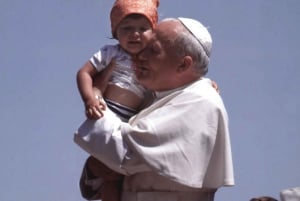
From Krakow: In the Footsteps of John Paul II
12 ReviewsThe tour gives you a chance to follow in the footsteps of the man who was to become one of the greatest Popes and human beings in history.
A Mecca to Poles and a birthplace of Poland as a country. Make sure to arrive early as the number of tickets sold are limited due to visitors comfort and security procedures.
Wawel Castle, the seat of kings and birthplace of legends, is arguably the most important symbol of Poland. It rises delicate and stately above the city at a bend in the Wisla river, flanked by grassy banks and wide boulevards, the cobbled paths of the medieval city at its feet. The graceful Wawel Cathedral, whose towers dominate the castle hill, reminds us that Poland's historical struggles for freedom and unification have been symbolically tied to Christianity for over a thousand years.
Slavic legend on Wawel hill reaches to the 7th century, when during the reign of Krakus the hillside cave was inhabited by a dragon that terrorized the city; the dragon was slain by a clever shoemaker, who tricked it into eating sheep stuffed with sulphur, until it became so thirsty that it rushed out to the river and drank until it burst. A statue of the dragon at the foot of Wawel hill today spews fire for appreciative crowds. The first king of Poland, Mieszko I (965-1025), chose Wawel as a royal residence. Its significance as a political centre was matched by its significance as the centre of Polish Christianity with the building of Wawel Cathedral around the year 1000.
Krakow became the royal capital at the beginning of the 14th century under King Wladyslaw Lokietek (the Short), marking both Kraków and Wawel forever as the cultural heart of Poland. Their golden age came under king Kazimierz the Great (1333-1370), who expanded both the castle and the city to unprecedented magnificence. The legendary Queen Jadwiga, whose marriage to the Lithuanian prince Wladyslaw Jagiello founded the Polish-Lithuanian Commonwealth that gradually expanded into the greatest European empire of the renaissance, reigned from Wawel's throne room. During its golden age, Wawel castle became a centre of humanism in Europe, renovated and decorated by Italian and German architects and painters, continuing until the Polish capital was moved to Warsaw in the 17th century.
Wawel's walls also witnessed the loss of Polish independence in 1795 and the installation of Austrian barracks among its royal chambers, a period which saw the destruction of much of the original castle and its conversion into a military hospital and insignificant border outpost. Austrian troops left the city by 1911, but the castle has never regained its original form.
Today, the foundations of the early hill settlement can be seen carefully unearthed in the shadow of the cathedral, while the castle complex has been beautifully renovated, its arched balconies a brilliant white intricately painted. Open to visitors are the rooms of state, including the elegant Senator's Hall where the throne once stood and the famous Envoys' Room, whose ceiling is studded with carved wooden heads; the private chambers; and the armoury, which contains an impressive collection of historical weaponry, including spears, swords, sabres, and cannon. Complemented by a tour of Wawel cathedral and the tombs of Wawel's kings, a journey through historic Poland must begin here, within the castle walls.
ps. Just two hundreds meters away Wawel, you'll find a restaurant called Pod Nosem and beautiful Apartments Kanonicza22.
My Guide Krakow is part of the global My Guide Network of Online & Mobile travel guides.
We are now in 120+ Destinations and Growing. If you are interested in becoming a local travel partner and would like to find out more then click for more info about our Website Business Opportunity.
Filter Events by Sub-Category
Please select a Date first.